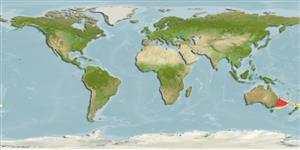Klassifizierung / Names
Namen | Synonyme | Catalog of Fishes(Gattung, Arten) | ITIS | CoL | WoRMS | Cloffa
Elasmobranchii (Haie und Rochen) (sharks and rays) >
Carcharhiniformes (Ground sharks) >
Scyliorhinidae (Cat sharks) > Scyliorhininae
Etymology: Cephaloscyllium: cephalus, from kephale (Gr.), head, referring to its very broad and depressed head; skylion, Greek for dogfish or small shark. (See ETYFish); variegatum: Latin for varied or various, referring to strong intraspecific and ontogenetic variability in color pattern and morphology amongst the specimens examined. (See ETYFish).
More on authors: Last & White.
Environment: milieu / climate zone / depth range / distribution range
Ökologie
seewasser bathypelagisch; tiefenbereich 114 - 606 m (Ref. 76948). Subtropical
Southwest Pacific: Australia.
Length at first maturity / Size / Gewicht / Alter
Maturity: Lm ?, range 63 - ? cm
Max length : 72.0 cm TL Männchen/unbestimmt; (Ref. 76948); 74.0 cm TL (female)
Kurzbeschreibung
Bestimmungsschlüssel | Morphologie | Morphometrie
This medium-sized species is distinguished by the following set of characters: head 9.4-10.5% TL in height, trunk width 14.5-17.1% TL; origin of first dorsal fin over or slightly behind mid pelvic-fin base; prenarial 4.4-5.0% TL in length; length of preorbital snout, 1.5-1.7 times prenarial length, 2.9-3.3 in prepectoral length, 6.4-7.2 in prepelvic length; snout-vent length long, 50.5-52.9% TL; nostril 2.4-2.6% TL in width; eye-spiracle space wide, 0.8-1.3% TL; pectoral fin large, height 12.9-13.2% TL, posterior margin length 10.4-12.1% TL; anal fin 3.5-4.1% TL in height; anal-caudal space 4.5-5.7% SL; precaudal 76-78% TL in length; interdorsal space 6.5-8.0% TL; teeth with 3-7 cusps near symphysis of upper jaw; flank denticles are mainly unicuspidate; back with no greatly enlarged denticles; long adult clasper, up to 8.1% TL, almost reaching anal fin, interspace about 5.4 in anal-fin base; vertebral centra 116-124; teeth in each jaw 68-82; variable colour pattern, not similar between adults and juveniles; adults have 11 distinct or indistinct dark saddle-like markings on body and tail while juveniles are without saddles, instead with fine blackish spots; predorsal saddles are not much wider than interspaces between them; interspiracular saddle width is subequal to eye length; obvious dark blotch over gill slits none; fleshy part of caudal fin appearing as a pale stripe, well demarcated from darker areas above and below (Ref. 76948).
Life cycle and mating behavior
Maturities | Fortpflanzung | Spawnings | Egg(s) | Fecundities | Larven
Last, P.R. and W.T. White, 2008. Two new saddled swellsharks (Cephaloscyllium: Scyliorhinidae) from Eastern Australia. In Last, P.R., White, W.T. & Pogonoski, J.J. (eds.): Descriptions of New Australian Chondrichthyans. CSIRO Marine and Atmospheric Research Paper no. 22. (Ref. 76948)
IUCN Rote Liste Status (Ref. 130435)
Bedrohung für Menschen
Harmless
Nutzung durch Menschen
Tools
Zusatzinformationen
Download XML
Internet Quellen
Estimates based on models
Preferred temperature (Ref.
123201): 12 - 17.7, mean 13.8 °C (based on 13 cells).
Phylogenetic diversity index (Ref.
82804): PD
50 = 0.5000 [Uniqueness, from 0.5 = low to 2.0 = high].
Bayesian length-weight: a=0.00263 (0.00139 - 0.00497), b=3.21 (3.04 - 3.38), in cm total length, based on LWR estimates for this (Sub)family-body shape (Ref.
93245).
Trophic level (Ref.
69278): 4.1 ±0.5 se; based on size and trophs of closest relatives
Widerstandsfähigkeit (Ref.
120179): niedrig, Verdopplung der Population dauert 4,5 - 14 Jahre. (Preliminary K or Fecundity.).
Fishing Vulnerability (Ref.
59153): Moderate to high vulnerability (50 of 100).
